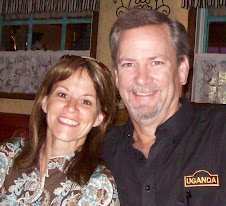
As parents, it is our instinct to help those we see in harm's way, isn’t it? The fallen child or the little one running towards traffic. But it is hard to assist those that we do not see, people who struggle every minute of every day, just to survive.
I have to admit, in the days I used to tuck my little babies into bed, I took their good health for granted. Being in Uganda for nearly eight months, we have been hit with the unfathomable number of people, babies and children that die here daily. 200,000 children under the age of five die annually. Of these, more than half die during their first year and 45,000 within the first month of birth. Nearly all of these 45,000 babies, and most of the 200,000, die from completely preventable causes and diseases. Now please reread those numbers. Staggering, yes?

Every woman deserves the security of knowing that her child will live another day.
If those sad statistics are not bad enough, one in seven African moms can expect to die as a result of pregnancy. The Commissioner of Social Affairs for the African Union says, “In Africa getting pregnant is a gamble between life and death.” A woman giving birth in sub-Saharan Africa is 100 times more likely to die in labor than a woman in a wealthy nation. These deaths occur in the early neonatal period and often result from obstructed labor or hemorrhage, which are linked to the delay or non-existent pre-natal care. No wonder expectant mothers here look at me with horrified expressions when I ask about their pregnancy or due date.
 Most at risk babies are born in rural village areas where health care is unaffordable or unavailable. Many of the deaths that occur in the baby’s first month are a result of poverty and lack of knowledge. The three major causes of newborn deaths are asphyxia, infections, and complications of premature birth.
Most at risk babies are born in rural village areas where health care is unaffordable or unavailable. Many of the deaths that occur in the baby’s first month are a result of poverty and lack of knowledge. The three major causes of newborn deaths are asphyxia, infections, and complications of premature birth.It should be noted here that all deaths from birth asphyxia can be prevented by use of proper equipment such as resuscitation kits. Yet, basic equipment and essential drugs for new-born care are lacking in most hospitals, and certainly unavailable in the villages.
Infection at birth is the number one robber of a newborn baby’s life. Sepsis, pneumonia, meningitis, tetanus and diarrhea are the single highest killers of newborns. Infections can be prevented through two simple doses of the tetanus vaccine during prenatal care, hygiene practices during childbirth and clean cord care after birth.
There are also many cultural practices that are recipes for infections and postnatal death; the application of ash by traditional birth attendants, or the shaking of a baby to start its breathing right after birth.
Premature birth is responsible for 25% of newborn deaths. More than half of the babies are born at home and mothers do not take their babies to be weighed. Even babies born in health facilities may not be weighed due to lack of equipment, broken equipment, or just the fact that some health workers do not have the skill or knowledge for weighing newborns.
Globally, Sub-Saharan Africa has the highest fertility rate. Uganda has the fourth highest fertility rate in all of Africa at an average of 7.6 births per woman. This results in shorter birth intervals, greater risk of newborn death, and malnutrition, as the mom’s breastfeeding capabilities diminish when there are two or more babies needing breast milk.
Basically, poverty and poor access to healthcare are the fundamental causes of all the newborn deaths in Uganda. Many of the deaths that occur in the first month are a direct result of poverty. Most of the at risk babies are born to young moms, in rural villages, in the bush, and slum areas who cannot afford healthcare. Even if the birth takes place in a hospital, there is no strategy to support newborns in their first week.
 We have witnessed firsthand the frustrations of delivering effective healthcare to a population with no electricity, no running water, and very little knowledge of or access to proper nutrition or health management. We are just doing a tiny part but have been so encouraged by the results from our Healthy Village and Family Workshops. The testimonies have fortified our belief that preventable diseases and illnesses can be fought by arming people with knowledge.
We have witnessed firsthand the frustrations of delivering effective healthcare to a population with no electricity, no running water, and very little knowledge of or access to proper nutrition or health management. We are just doing a tiny part but have been so encouraged by the results from our Healthy Village and Family Workshops. The testimonies have fortified our belief that preventable diseases and illnesses can be fought by arming people with knowledge.
 We have witnessed firsthand the frustrations of delivering effective healthcare to a population with no electricity, no running water, and very little knowledge of or access to proper nutrition or health management. We are just doing a tiny part but have been so encouraged by the results from our Healthy Village and Family Workshops. The testimonies have fortified our belief that preventable diseases and illnesses can be fought by arming people with knowledge.
We have witnessed firsthand the frustrations of delivering effective healthcare to a population with no electricity, no running water, and very little knowledge of or access to proper nutrition or health management. We are just doing a tiny part but have been so encouraged by the results from our Healthy Village and Family Workshops. The testimonies have fortified our belief that preventable diseases and illnesses can be fought by arming people with knowledge.With the support of the local pastors and one local nurse, we began our Healthy Village workshops at the grassroots level in several remote villages that had little or no Western style healthcare. We implemented a village-driven training program based on the training Mike did in the states through CERF, the concepts presented in the reference book, Where There is No Doctor; A Village Health Care Handbook, and The Health Education Program for Developing Countries. The two initial and lengthy trainings we taught brought to the top the most dedicated trainers to continue the training throughout the villages. Forty-two driven grads are now out spreading the word in their villages.
 In our first training we conducted a simple health survey asking participants to identify the biggest problem they faced in the past year. Sadly, poverty proved to be a major issue and huge barrier to healthcare. Villagers could not afford to eat properly or buy nutritional supplements or appropriate medications. They did not have access to safe water for drinking or bathing. They did not know proper ways to handle excrement. They did not have fuel in which to cook by, or boil water. They typically could not afford to travel to reach a clinic or hospital, and due to fear of medical costs, they would often remain in the village and die.
In our first training we conducted a simple health survey asking participants to identify the biggest problem they faced in the past year. Sadly, poverty proved to be a major issue and huge barrier to healthcare. Villagers could not afford to eat properly or buy nutritional supplements or appropriate medications. They did not have access to safe water for drinking or bathing. They did not know proper ways to handle excrement. They did not have fuel in which to cook by, or boil water. They typically could not afford to travel to reach a clinic or hospital, and due to fear of medical costs, they would often remain in the village and die.Other challenges were inadequate or nonexistent diagnosis before treatment; ineffective treatment; and the pervasiveness of superstition, ignorance, and influence from witchdoctors.
The responses to our initial classes helped us shape our current program. We center our Healthy Village and Family training around the most significant health challenges, like Malaria, AIDS, STD’s, tuberculosis, pneumonia, diarrhea, goiter, anemia, malnutrition, worms and other parasites, lack of prenatal care, limited access to immunizations, and lack of clean water and sanitation.
 We have been blessed with some donations of medical supplies from friends in the states. And because of the generosity of others who share our passion to eliminate the suffering of the Ugandan people we have been able to add bandages, some medications, beds, mattresses, bedding and mosquito nets to the clinic. There is a lot more training that needs to be done, to share knowledge and prevent preventable deaths and suffering. Medications are difficult for the locals to procure for the clinic. But with funding we’re able to buy medications for them. The general lack of donations forces us to be resourceful and creative…to improvise; banana leaves for bandages, ways to recognize and diagnose anemia, malnutrition, worms and dehydration without equipment or tests; methods in which to treat water without cooking fuel or power; ways to cook without charcoal or firewood.
We have been blessed with some donations of medical supplies from friends in the states. And because of the generosity of others who share our passion to eliminate the suffering of the Ugandan people we have been able to add bandages, some medications, beds, mattresses, bedding and mosquito nets to the clinic. There is a lot more training that needs to be done, to share knowledge and prevent preventable deaths and suffering. Medications are difficult for the locals to procure for the clinic. But with funding we’re able to buy medications for them. The general lack of donations forces us to be resourceful and creative…to improvise; banana leaves for bandages, ways to recognize and diagnose anemia, malnutrition, worms and dehydration without equipment or tests; methods in which to treat water without cooking fuel or power; ways to cook without charcoal or firewood.
Why is it okay for a woman giving birth in Uganda to be 100 times more likely to die in labor than a woman in a wealthy nation? Why is it okay for 200,000 babies to die every year? Why is it okay for 320 people to die DAILY in Uganda alone from Malaria…mostly children and pregnant women? Why does life or death depend on where one is born?
There are many challenges that face the people of Uganda that need to be addressed. Want to roll up your shirt sleeves and work beside us? Find out ways you can help change the lives of people in Africa. Check out our website; www.onecityministries.org





A couple hundred ounces of PREGNANCY prevention would be good! 7.6 births per woman? Ugh.
ReplyDeleteThank you for all the work that you do!
ReplyDelete-Ingrid
Hesperian, publishers of Where There Is No Doctor and other books on health.